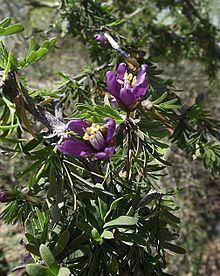Genus Guaiacum Higher classification Guaiacum | ||
 | ||
Similar Guaiacum, Zygophyllaceae, Guaiacum coulteri, Guaiacum sanctum, Porlieria | ||
Guaiacum angustifolium is a species of flowering plant in the caltrop family, Zygophyllaceae. Common names include Texas guaiacum, Texas lignum-vitae, soapbush and huayacán. It is native to southern and western Texas in the United States and northern Mexico. The specific name is derived from the Latin words angustus, meaning "narrow," and folius, meaning "leaf."
Contents
Description
Texas lignum-vitae is a many branched shrub or small tree, reaching a height of 7 m (23 ft). This evergreen has a dense canopy and short lateral branches.
Leaves
Leaves are 1–3 cm (0.39–1.18 in) long, opposite and pinnately compound, with four to eight pairs of leaflets. The dark green, leathery, linear to linear-spatulate leaflets are 5–16 mm (0.20–0.63 in) long and 2–3 mm (0.079–0.118 in) wide. Leaflets fold themselves at night and when exposed to hot sunlight.
Flowers
The small blue to purple flowers are 12–22 mm (0.47–0.87 in) in diameter. They have five sepals, five petals around 1 cm (0.39 in) in length, and ten stamens. The blooming period lasts from March until September, with flowers appearing after rain.
Fruit
The fruit is a flat, leathery capsule 1–2 cm (0.39–0.79 in) in diameter with one to two lobes, sometimes as many as four. Dehiscent locules contain a single shiny, bean-like seed that is usually bright red.
Uses
Like other species in its genus, the wood of G. angustifolium has extreme hardness and density and will sink in water. The sapwood is creamy yellow, while the heartwood is dark purple-brown. The wood is used for fence posts, tool handles, and firewood. Root extracts are used to treat rheumatism and sexually transmitted diseases. Soap can be made from the root bark because it contains saponin; historically soap made in this way would be used to wash wool. The flowers are valued by beekeepers for their consistent nectar production. Texas lignum-vitae is cultivated as an ornamental because of its drought tolerance, dense foliage, compact size, gnarled branches, and fragrant flowers. It is used in hedges, rock gardens, and xeriscaping.
Ecology
Guaiacum angustifolium is a host plant for the caterpillars of the lyside sulphur (Kricogonia lyside). The leaves contain 16-18% crude protein and are browsed by White-tailed deer.
Conservation
Like other members of its genus, the international trade of Texas lignum-vitae is restricted by CITES Appendix II. Only seeds, pollen, and finished products ready for retail sale may be legally exported.
